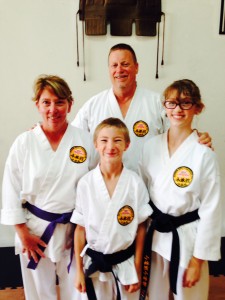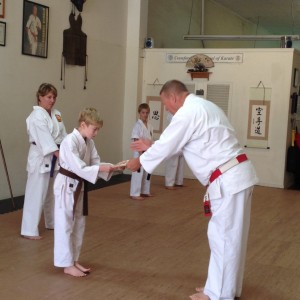With a Masters in Exercise Physiology and Neurobiology, common sense would tell you that this weeks Health Hero Liz Oschel would decide to get back into shape through…. KARATE?
For the last 10 months Liz, who is legally hanging on to her 40’s, has been working in Tom Ward’s, Crawfordsville School of Karate. Liz trained in Hip Kido during college and decided to enter Tom’s Dojo, or “place of the way” for training in self defense.
Tom, or “Sensei” to the students, has been involved with Karate for 41 years and has taught for 36. Sensei is very interested in seeing his younger students excel in all avenues. If a child is having issues at school, they have issues in the Dojo. He will provide tutoring for students. But being in the Dojo is a privilege. Words like “respect,” “integrity,” “humility,” “courtesy” and “self control” are braided into training. Tom works with ADHD and ADD children to improve concentration skills.
This fits well for Liz and her husband Steve who have two children: Mariel, age 12 and Dirk, age 11. Dirk has been in Karate for 7 years, Mariel five-ish. They are both first degree black belts. Mariel has recently retired from competition, but will continue to study and has many friends in karate. In a recent competition, in New Orleans, Dirk won a World Championship in Chanbara, which is padded sword fighting. Steve and Liz agree that the sacrifices of travel and finances are well worth the benefits.
Liz is impressed with not only her physical improvement but what it has done for her nervous system. She was surprised by the response of her brain function, especially her cerebellum. Nerve “messages” are called stimuli; they stimulate the brain into a response. All this is recorded. The more practice, the stronger the “nerve program” becomes. It’s called neuroplasticity, or the summation of synaptic expression. In short, repetition makes the master.
As a result, Liz feels she has better motor skills countering the aging process. She has realized weight loss and increased lean body mass. She runs to improve cardiovascular stamina which improves her sparring.
“Defensive skills are learned while stimulating the sympathetic nervous system. This simulates attack conditions and prepares a person to respond. It’s better to act with a plan,” she explains. She loves the goal setting and positive attitude. “Many of the children who compete have parents who train. It is very much a family sport.”
The type of Karate Sinsei teaches is called Shorin-ryu, with it’s origins in Okinawa. Safety is ALWAYS stressed. The first rule in training is to take care of your partner. Head gear with face shields and hand pads are used for protection. Practicing technique is important to prevent injury. Students are not required to spar in order to learn Karate. The first lesson is to avoid being in compromising situations.
As I interviewed Liz and her family, Jacob Hutson, 11 year old son of Darren and Paula Hutson, tested his first degree brown belt. It was an impressive display of precision movement even to the untrained eye. In a ceremony that followed, Sincei presented Jacob with his certificate. He had advanced. His goal is to reach a black belt or Shodan, before the end of the year.
For now our Health Hero is good with kicking and running and striking and sparring and punching her way to a healthier life. Hey Liz, when someone yells “duck”, don’t go looking for feathers!


